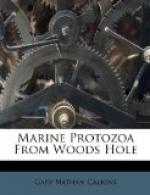Trachelocerca phoenicopterus Cohn ’66. Fig. 30.
Synonyms: T. sagitta Ehr. ’40, Stein
’59; T. tenuicollis
Quennerstedt ’67, Kent ’81; T. minor
Gruber ’87, Shevyakov ’96.
The body is extremely elongate and ribbon-like, and this, combined with its wonderful power of extension and retraction, makes it one of the most curious and interesting of microscopic forms. The anterior end is square or cylindrical; the type species has a four-sided mouth, but many specimens may be found which have a plain cylindrical mouth region. One reason for this may be the fact that the extremity gets broken off. In one instance I noticed a very large form with the anterior end under some debris, which evidently held it tight, for the body of the ciliate was thrashing back and forth and twisting itself into knots, etc., like a nematode worm. Finally, the anterior end broke off with about one-tenth of the body; the remainder, in an hour, had regenerated a new anterior end with long cilia, but with no indication of four sides. The small anterior piece was also very lively, moving about and eating like the normal animal; its history, however; was not followed. This species appears to be variable in other ways as well; thus, in some cases the posterior end is rounded (cf. Entz ’84); in others it is pointed (cf. Kent ’81, Cohn ’66, et al.).
Again, the macronucleus may be a single round body (Entz ’84, Buetschli ’88) or in two parts (Kent ’81), or in many parts scattered about the body (Gruber). In the Woods Hole forms the tail is distinctly pointed and turned back sharply, forming an angle at the extremity. The cilia on this angular part are distinctly longer than the rest. The function of this posterior part is apparently to anchor the animal while it darts here and there upon the tail as a pivot, contracting and expanding the while. The body is finely striated with longitudinal markings; when contracted there are no transverse markings nor annulations. The nucleus is in the form of many fragments scattered throughout. Length of large specimen 1.7 mm.
[Illustration: Fig. 30.—Trachelocerca phoenicopterus.]
Genus MESODINIUM Stein ’62.
(Maupas ’82, ’84; Entz ’84; Shevyakov ’96.)
The main part of the body is globular or conical, with a short, platform-like oral region, and a deep annular groove about the middle of the body. The oesophagus is rather long, and smooth or longitudinally striped. One or more rings of cirri rise in the groove. If more than one ring of cirri are present, the anterior set usually point forward and lie close to the anterior part of the body. The posterior set, on the other hand, cling close to the posterior region of the body and give to it a peculiar encapsuled appearance. The most characteristic feature is the presence of four short tentacle-like processes which can be protracted and retracted from the oral region. (Mereschowsky says that the entire anterior half is more or less contractile.) The macronucleus is horseshoe-shaped or ovoid and is situated in the posterior half of the body. The contractile vacuole is also posterior.




